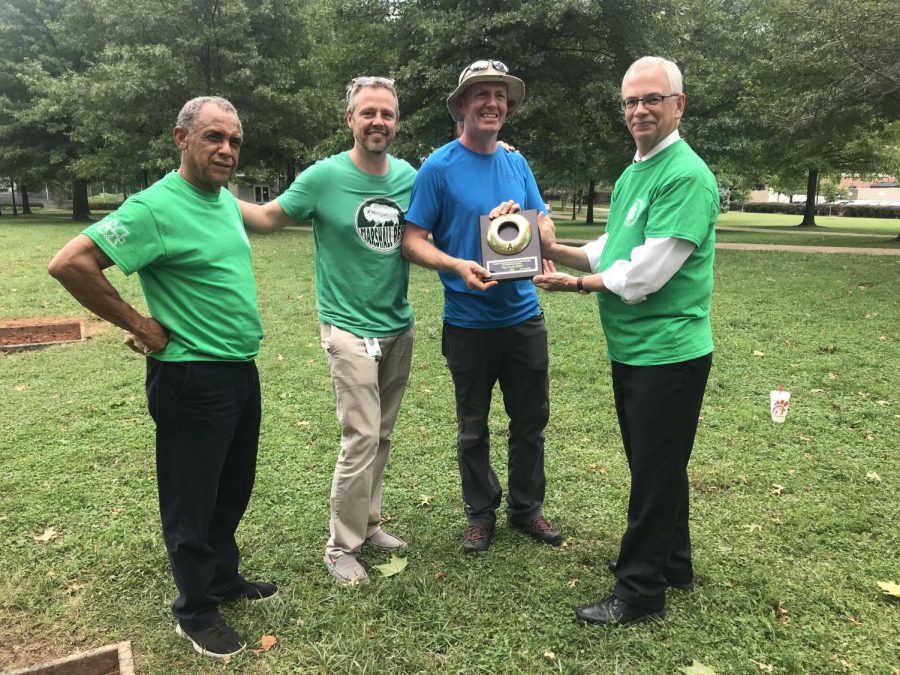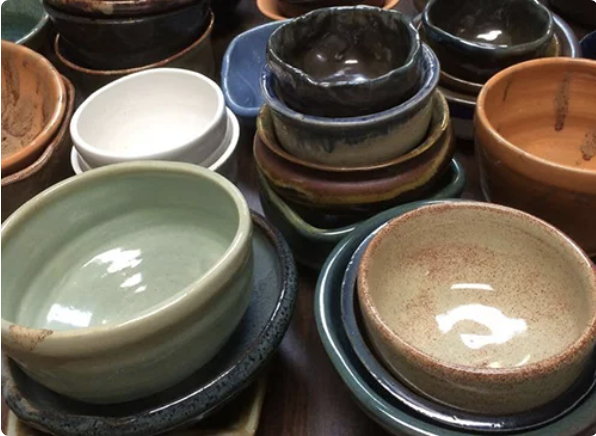Quoits – the age old game of Marshall University
Maurice Cooley and President Jerry Gilbert present a plaque to Spin the Bronze Circle, for winning the annual Quoits tournament Sept. 19. From left to right, Maurice Cooley, Dave Daniel, Bill Rawlinson and President Gilbert.
Quoits is the game Marshall University students and faculty participate in yearly in celebration of John Marshall’s birthday.
“Quoits is an old game that goes back until at least the 1700’s,” President Jerry Gilbert said. “It pre-dated John Marshall. It was his favorite game, and he played it weekly.”
The game and its rules are similar to horseshoes; players will throw a quoit and try to get on or as close to a spike as possible.
“Quoits typically, but not necessarily, will have a box at either end of the quoit field,” Gilbert said.
The box is three feet by three feet, and it has the spike, which is the target for the quoit. The quoit is a round disk with a hole in the middle, is made of metal and weighs three to five pounds.
“It is a pretty heavy disk, and it is probably about eight or 10 inches in diameter with a hole in it that is about two inches in diameter,” Gilbert said. “There is plenty of room for it to go on the spike that is in the box, that is the pit.”
The quoit is rounded, as it has an up and a down side.
“You can think of it like a Frisbee in the sense that it has a top and a bottom,” Gilbert said. “The quoit is not shaped exactly like that but it has a top and a bottom.”
The goal of the game is to land the quoit in the pit with the top up and get closest to the pin.
“If you can get on the pin, that is the best location you can get,” Gilbert said.
Players will create teams and stand on either ends of the field. The distance between each pin is 21 feet, or seven yards. Each team of two will have a member on each end creating Team A and Team B. One team will have an A player and B player on one end playing against an A and B player on the opposite team.
“When I play with Maurice Cooley, I stand on one end of the court and he on the other,” Gilbert said. “I am playing against one of the two team members we are playing against, and he is playing the other. If you have a very strong player and one not strong player, the strategy of how you might pair up with the other team depends on your motives. You can pair a strong against a weak player or two weak players together. There is some strategy on how you pair them up. I always let Maurice handle that.”
The game is played until one team has reached the score of 21. The typical score is one, and this occurs when a disk is thrown closest to the pin, within a diameter of one quoit from the pin.
“You have a three foot box,” Gilbert said. “When you end up way away from the pin, further away from one diameter of the quoit, you do not get any points.”
When checking the score, first determine if Team A or B is closest to the pin and whether their quoits are in legal play. Legal play means they have not touched the ground before they went into the pit, or they have not hit the sides of the pit before landing inside of it. The team closest to the pin gets the point.
“If you have another quoit on your team that is also close to the pin, you get two points,” Gilbert said. “If you happen to lean the quoit against the pin, you get two points, and if you are actually on top of the pin, meaning you have done a ringer, which is when the hole of the quoit is on the pin you would get three points. That is all assuming the quoit is right side up. If it is upside down it does not count no matter where it is.”
There are different ways to throw the quoit. Some players use a throw similar to a flying disk, which is from the side. Some players throw it straight on to the pin, some players flip it and have it going end over end as it heads towards the pin.
“It is a big risk because you never know if it is going to land up or down,” Gilbert said. “That is probably not a good strategy. I like to do a modified Frisbee where you give it a little bit of a spin as you come off. I’m not very good, but Maurice Cooley is excellent. He is very good at placing the quoit.”
Players can knock the quoit out of play. If there is a quoit leaning against the pin, one can throw a quoit into the pit and knock it off bringing the quoit from a possible two points to no points. Typical games last about 20 minutes.
“It is a very fun game,” Gilbert said. “I’ve enjoyed doing it. My first year I had a shoulder injury, so I could not actually throw it. That was during the investiture when I was being invested as the president of Marshall. I had a nephew who was here who was very athletic, and he played with Maurice and won the whole thing. The second year I was able to throw it.”
Gilbert and Maurice Cooley came in second place this year to Spin the Bronze Circle.
“I think it is neat that this university has a sport that anybody can play,” Gilbert said. “It is also tied to John Marshall. It’s a great game. Its rules date back to a time where it was supposed to be a game of civility where you would not talk about anything controversial. You only talked about pleasant things. It was a way to get people to play against each other in a light-hearted fashion and not discuss the negative subjects of the day.”
“Quoits has a huge historical significance to the university,” Cooley said. “It is a great way for the university to celebrate and recognize constitutional week. It is also a great way to show comradery and friendship among staff, faculty and administrators here at the university, to come together for a fun experience throughout the week. It certainly is an honor personally to be selected as the president’s partner. And it does not matter whether you win or lose; being the president’s partner is a big deal. I hope as we build or recognition, the more our students will become familiar with the game of quoits.”
Gretchen Kalar can be contacted at [email protected].
Your donation will help continue the work of independent student journalism at Marshall University. If you benefit from The Parthenon's free content, please consider making a donation.





